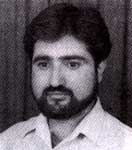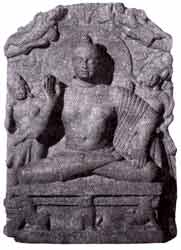

MATHURA-A TREASURE TROVE OF ANTIQUITIES
BY VIRENDRA BANGROO
ARTICLE – Mathura, the holy city that is most popularly associated with Lord Krishna is a pilgrim centre for the Buddhists and the Jains alike. It has a long and chequered history, having been invaded several times and razed to ground on four occasions. But the city came up again and again, faster than it was destroyed. Today, Mathura is not only a pilgrim centre but also a rich treasure trove of various are forms and relics of several faiths that are part of the Indian Sansktriti.
| Mathura, the birthplace of Lord Krishna, was a flourishing business centre, situated as it was at the junction of Daksinapath (southern route) and Uttarapath (modern route). Caravans used to break the journey and camp here. Due to this economic activity, elegant buildings and temples came up in the city. In fact, the Kushanas, understanding the value of Mathura, unfurled their victory flag here and made it their political capital. The rulers also contributed to the city some of its most imposing buildings and public facilities, the ruins of which can be seen at the Mathura state museum.
Situated on the right bank of the river Yamuna, Mathura is about 145 km. from Delhi. There are several theories about the origin of the name of the city. According to some it derives its name from Madhu (honey). Some relate it with the Demon King Madhu. All these explanations have not been proved philologicaly. In literary texts this place is referred to by various names viz. Madhuban, Madhupathno and Madhupuri. Yamuna served as a navigation channel to this trade city about which we find detailed accounts in the Brahad Kalpasutra, the Jain religious text. Garuda Purana gives it a prestige of Moksh dayni (place of salvation). Other Puranas attribute its foundation to Shatrugan, brother of Lord Rama, By the Mahabharata age it had emerged as splendid city. In the 6th century BC it became the capital of Shursen republic, which was one of the 16 Janapadas (independent republics). Mathura was not a mere trade centre. It was also bustling with cultural activity, though it was only during the reign of Mauryas (circa.323 to 185 B.C.) that the Mathura school of art gained a distinct identity. This is supported by ample evidence in the form of terracotta and stone sculptures. During the Mauryan period, Yaksha worship was in vogue, the representation of which we find both in terracotta and stone. In the Mathura museum we find various examples of huge Yaksha images. Figures of Yaksha from parkham speak volumes about the sculpture of this school. There are also images of Brahminical, Buddhist and Jain icons. When the Kushanas came as intruders, Mathura was the biggest trade centre in the region. In order to gain the confidence and support of local population, the Kushanas (circa late first century B.C. to third centruy A.D.) made the images of the entire Hindu pantheon. To show their supremacy, they cast their own images also. Some of the images are in the Mathura museum today. The Mathura school of art, which enjoyed the royal patronage made the greatest contribution to plastic art in India. According to eminent historian Dr. R.C. Sharma, it was at Mathura that the first icon of Buddha was shaped. This formed the framework for subsequent Buddha images. Some scholars say that the first image was made in the Gandhar region, where the tradition of image making already existed, influenced by Greek and Roman art. However, Dr. Sharma asserts that the first school to caste the image of Buddha was at Mathura, because here existed then the tradition of making Yaksha images and in the Buddhist images too we find the same characteristics. These early Buddha images can be dated to 1st century A.D. on stylistic grounds. Archaeological excavations at sites in and around Mathura have yielded rich material. On the basis of such evidence, an unbroken chain of civilization and human habitation can be traced in this area from 1st millennium B.C. One of the earliest excavations was done by Cunningham in 1871. He excavated Kankali tile, a mound of about 1/2 km. diameter in the heart of the city. This mound yielded many Jain sculptures. According to an inscription (shila lekh) there was a Jaina stupa at the site. At Matt, 15 km. from Mathura, on the left bank of Yamuna another site was excavated. From this place, referred to as Devkul in the inscriptions, the statues of Vima Kadaphises (the second king of the Kushanas), Kanishka and Hoviska were found. these images are different from the images of Mathura school and the images were built so as to stamp the might of their rule. The first portrait image was that of Vima Kadaphises. No ruins are seen around the mound at Matt. Devkul can said to be the first museum of its kind. In 1975, a tank dating to Kushana period was excavated by Sh. M.C. Joshi, former Director General, Archaeological Survey of India. The tank is lined with baked bricks. An inscription in the site mentions the date as 5 Kanishka. Many sculptures dating to 2nd century B.C. to 2nd century AD were found here. Most of the excavated objects are now preserved in the Lucknow State Museum and some are housed in the Mathura Museum. That Mathura was an important religious centre for the Jains is evident from excavated material and Jain literature. Jainism couldn’t get the royal patronage of the kings but it flourished side by side with Buddhism and Hinduism and was aided by rich merchants and traders. Mathura is a revered place for Jains because it is the birth place of the 23rd Tirthankara – Neminath, the cousin brother of Krishna. Lord Mahavira is also said to have visited this place. Lord Buddha also visited Mathura. His remarks were not positive. In Lalit vistar, a Buddhist text, Buddha has referred to this place as dusty, rustic and where Yakshas roam freely. He has said that there were a lot of stray dogs and it was difficult to collect the alms. Till 6th century AD Buddhism enjoyed the patronage of the Kushana kings and Mathura became a prominent centre for Buddhist learning. However, by 7th century AD, Buddhism had completely disappeared from the city. The Sunga (circa 2nd Century to 1st Century B.C.) and the Kushana age were the golden era for Mathura. During this period it was a cosmopolitan, renowned city and a brisk trading centre, It was an important centre during Mauryan times also. It lost its royal seat after the Kushanas and did not enjoy the same political status afterwards. Despite political changes and power shifting hands, Mathura continued to thrive as a vibrant city with rich material and cultural wealth. Excavations carried out at Sonkh under the German Archaeologist Prof. H. Harstel, have unfolded a cultural continuity from 1st millennium B.C. to 9th century A.D. Some of the antiquarian wealth is deposited in the Mathura Museum and the rest are in the Archaeological hut at Sonkh. The Mathura school of art has left and everlasting influence on art and architecture in the rest of the region. The author is the Documentation Officer, in Kalanidhi Divison.
|
[ Newsletter | List of Newsletter ]




